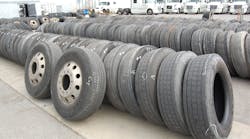Manager: Dan Engelsen
Title: Sales engineer
Company: Innovative Products of America, Woodstock, NY
Operation: Automotive and truck maintenance shop tool supplier
Problem:
Every fleet recognizes the critical role tires and proper tire care play in keeping trucks up and running. Poor tire inflation, for example, not only affects overall fuel economy but shortens tire life expectancy—creating a double-whammy to the bottom line of carriers.
Yet Dan Engelsen and his fellow engineers working at shop tool supplier Innovative Products of America noticed something else when talking to maintenance professionals: Few had all the key elements for proper tire care.
“We noticed in our conversations with fleets that there always seemed to be a missing link when it came to their tire care practices,” Engelsen says. “We found many of them didn’t quite connect all the tire-related dots in their maintenance operation, which could add up to bigger problems down the road.”
Indeed, he likens it to the famous “butterfly effect” coined by Edward Lorenz, an American mathematician and meteorologist. Lorenz theorized that the impact of small, incremental events can multiply in intensity over time.
“We found many were well aware of the overall impact proper tire inflation has on fuel economy and on tire life, but some didn’t realize how proper tire diameter on dual tire sets could generate similar impact,” Engelsen explains.
Solution:
With Lorenz’s maxim in mind, Engelsen and the engineering team at Innovative Products crafted a white paper dubbed “The Butterfly Effect on Tire Maintenance.” The paper features as much tire care-related knowledge as possible and serves as a reference tool for fleet maintenance personnel.
For example, the paper focuses on the importance of tire pressure gauge accuracy and how the proper care of gauges can directly impact the proper care of tires over time. “The gold standard, if you will, is a gauge with only a 1% swing in tolerance,” Engelsen says. “That, of course, depends on the quality of the gauge you purchase and how you keep it calibrated over time. Many times tire inflation gauges get tossed around in a shop and get damaged—and that can affect the accuracy of its readings.”
He points out that a gauge that is off by 3% one way or the other can potentially report a 12% variance in tire pressure among a full set of duals (four tires total) on either trailer axles or the rear axles of a highway tractor.
That impact can be significant. According to research conducted by the National Highway Safety Administration, the average deterioration in fuel economy due to underinflated tires is 3.3%, which results in over $2,400 in extra diesel costs per power unit for every 125,000 mi. of operation
Additional industry research indicates that every 10 psi of underinflation causes tire tread to wear between 9% and 16% faster; likewise, 10% overinflation will cause 5% faster wear. Either way, faster wear leads to premature removal of tires, increased maintenance costs, and potentially unwanted CSA violations for low tread depth, according to industry data.
Furthermore, the U.S. Government Accountability Office estimates that 25 to 50% of truck tires are underinflated by 8 psi or more. Indeed, Goodyear and Michelin both note that research shows running tires that are 20% underinflated will reduce tire life by up to 50%.
Another issue addressed by Innovative Products’ white paper is how to ensure dual tire sets are matched together with equal diameter.
“It’s easy to overlook the importance of diameter,” Engelsen says. “But if one tire in the set is 1/2 in. smaller in diameter than the other, that smaller tire will get ‘dragged’ by the larger one by about 5.2 ft. for every mile traveled. That creates several issues, from reduced fuel economy to reduced tread on the dragged tire as well as greater wear on the one doing the dragging.”
Again, he stresses that these are some of the small things that can eventually lead to bigger problems down the road for truck and trailer tires if they aren’t addressed.



